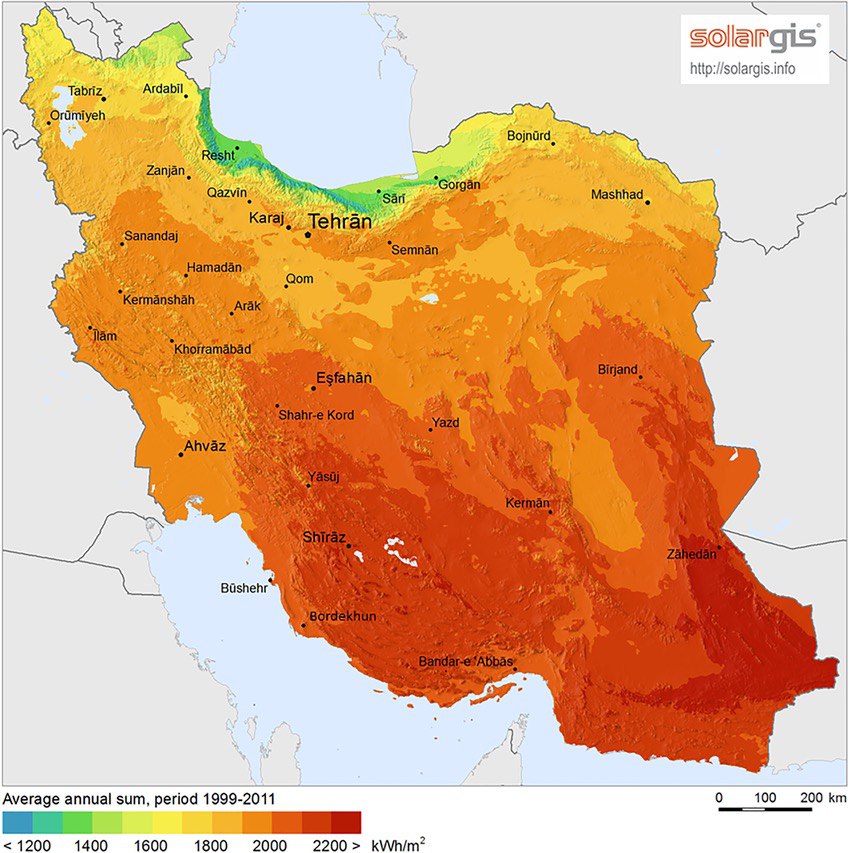
refers to the capability of producing electrical energy through solar panels on a worldwide scale. This potential is determined by various factors that directly affect the amount of energy that can be produced by solar panels. Below, we explore these factors and provide insights into the photovoltaic potential in Iran.
1. Solar Irradiance:
Solar irradiance refers to the amount of solar energy reaching the Earth’s surface. This amount varies depending on geographical location and weather conditions. Regions closer to the equator typically receive higher solar irradiance.
2. Weather Conditions:
Clouds, dust, and other weather conditions can reduce the amount of solar irradiance received by the panels. Dry and desert regions usually have favorable weather conditions for harnessing solar energy.
3. Topography:
The type and shape of the land also affect the angle of solar irradiance and the efficiency of the panels. Flat and unobstructed lands provide the best conditions for installing solar panels.
4. Photovoltaic Technology:
The technology and efficiency of solar panels directly impact the amount of energy produced. Higher-efficiency panels can capture more energy from solar irradiance.
5. Land Use:
The availability of land for installing solar panels is another crucial factor. Using desert and non-arable lands for solar installations can be an excellent option without interfering with other land uses.
Iran, with its favorable geographical and climatic conditions, is one of the countries with high potential for solar energy production. Below are some reasons for Iran’s high photovoltaic potential:
1. High Solar Irradiance:
Due to its geographical location, Iran is one of the countries with the highest solar irradiance in the world. The country enjoys over 300 sunny days a year, making it one of the best places for utilizing solar energy.
2. Favorable Weather Conditions:
Many regions in Iran, especially central and southern areas, have dry and sunny weather conditions, making them ideal for the installation and operation of solar panels.
3. Vast Desert Lands:
Iran has extensive desert areas and lands unsuitable for agriculture. These lands can be used for installing solar panels without conflicting with other land uses.
4. High Technological and Investment Potential:
By investing in advanced photovoltaic technologies and developing the necessary infrastructure, Iran can become one of the major solar energy producers. Developing the solar energy industry helps provide sustainable energy and creates new job opportunities.
Despite Iran’s high solar energy potential, some challenges must be addressed. These challenges include the need for high initial investments, the development of necessary infrastructure, and the formulation of supportive policies by the government.
On the other hand, there are numerous opportunities in this field. By harnessing solar energy, Iran can reduce its dependency on fossil fuels and decrease environmental pollution. Additionally, exporting solar energy to neighboring countries can provide a new source of revenue for the country.
The global photovoltaic power potential, especially in countries like Iran with favorable geographical and climatic conditions, can play a crucial role in providing sustainable energy and reducing environmental impacts. With investment and development of appropriate infrastructure, Iran can harness this clean and renewable energy source and become a leader in the solar energy sector.



Global Photovoltaic Power Potential is assessed and calculated based on a set of standards and guidelines. These standards are established by international and national organizations to ensure accuracy and reliability in measurement and reporting. Below are some key standards in this field:
– ISO 9060: This standard pertains to solar radiation measurement equipment such as pyranometers. These instruments must be accurate and calibrated to collect solar irradiance data correctly.
– IEC 61724: This standard focuses on the monitoring and measurement of photovoltaic system performance, including the methods and equipment required for accurate energy production assessment.
– IEC 62548: This standard addresses the design and installation of photovoltaic systems, providing guidelines for ensuring the safety and efficiency of these systems.
– IEC 60364-7-712: This section of the IEC standard deals with the electrical installation of photovoltaic systems, including safety requirements and proper installation practices.
– IEC 61853: This standard determines the performance and efficiency of photovoltaic modules under various environmental conditions. It includes defining performance curves and analyzing data from environmental tests.
– IEC 61727: This standard pertains to the grid connection requirements of photovoltaic systems, covering aspects such as power quality and grid stability.
– ISO 14040: This standard deals with the life cycle assessment (LCA) of products and systems, used for evaluating the environmental impacts of photovoltaic systems.
– ISO 14044: This standard provides details and methodologies for conducting LCA, helping to analyze the environmental impacts throughout the life cycle of products.
– IEC 62446: This standard includes requirements for testing, documentation, and maintenance of photovoltaic systems, ensuring long-term performance and safety.
Given Iran’s high potential for solar energy production, the implementation of these standards can significantly improve the quality and efficiency of photovoltaic systems. In Iran, utilizing international standards such as ISO and IEC can aid in achieving long-term renewable energy goals and enhancing the solar energy industry.
Applying these standards in Iran may come with challenges such as the need for technical training and expertise, initial investment in standardization equipment, and the development of necessary infrastructure. However, by leveraging its high solar potential, Iran can become a leader in solar energy production.
Adhering to international standards in solar irradiance, design and installation, performance and evaluation, environmental impacts, and management and maintenance of photovoltaic systems is crucial for optimizing global photovoltaic power potential. These standards ensure quality, safety, and efficiency, supporting the sustainable development of renewable energy worldwide, particularly in high-potential countries like Iran.
For more information, purchasing products, or any inquiries, please contact us through the following details:
Landline: +98-21-88770680
WhatsApp: +98-912-6835639
Telegram Group: SAVA Trade Group
Our team is ready to assist you with any inquiries and meet your needs.
Feel free to reach out to us, and we will be happy to help you with your questions and requirements.
